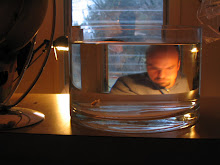Thursday, May 1, 2014
The condition of fun
"All art," Walter Pater once argued, "aspires towards the condition of music."
Well, okay. Here at halfstep, we're hardly opposed to the bold truism. But precisely because we spend so much time in the company of a certain 4-year-old, we also have our doubts about Pater's assertion. In fact, after walking through Alan Siggers' remarkable MFA thesis show yesterday, we would confidently suggest that some art aspires towards the condition of savvy fun.
The centerpiece of Siggers' show (which shares a gallery in MICA's Fox building with the work of four other MFA candidates) is a sprawling ensemble of repurposed architectural forms - second-hand doors; used banisters - and painted plywood that forms a devilishly irrational series of spaces. Doors open onto tiny rooms, which give way to stairs that seem to lead into walls - which, in turn, surprise us by giving way to slight pressure. Tight right angles force us to turn our body, and to lose track of our place in space. And, meanwhile, the architecture gently taunts us: a lintel protrudes, only partially supported, into space but does no apparent work, and further flights of stairs climb provocatively up the walls of the gallery, but cannot be accessed. Painted in a bright series of pastel tones, the installation is ridiculous, and takes considerable joy in that fact.
And yet, it also suggests a fluid, intimate art historical self-awareness. In its almost organic organization, the piece loosely recalls, for instance, Kurt Schwitters' celebrated (but lost) Merzbau, an accretion of forms built in the artist's home over the course of five years in the 1920s. At the same time, it also prompts comparisons with the sharp, canted angles of The Cabinet of Dr. Caligari - and, too, with the impossibly protean forms of Surrealism. But wait: as you wander through it, you might also think of that band of works from the 1960s that forced viewers to pay a renewed attention to their own place in a compressed space: to Robert Morris' passageway, for instance, or Bruce Nauman's video-taped corridor. And then, too, there's that lintel: a soft and playful gesture, in my mind, toward the openly non-functional postmodernism of architects like Charles Moore. As we emerge, then, we not only step out of a work of art: we exit a dense web of art historical allusions.
And, as you can see in the photo above, at least some of us do so with a big smile on our face. So, then: let's put it this way. Art may aspire, in some arguable sense, to the condition of music. But, happily, it can aspire to other things as well - and, in the process, can kindle a range of forms of delight.
Subscribe to:
Post Comments (Atom)





No comments:
Post a Comment